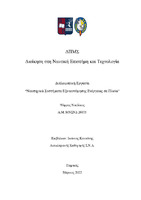Ναυπηγικά συστήματα εξοικονόμησης ενέργειας σε πλοία

Προβολή/
Λέξεις κλειδιά
Ενεργειακή απόδοση ; Εξοικονόμηση καυσίμου ; Μείωση εκπομπών αέριων ρύπωνΠερίληψη
Η παρούσα διπλωματική εργασία πραγματεύεται τις νέες τεχνολογίες ναυπηγικών συστημάτων που εφαρμόζονται στα πλοία προκειμένου να περιοριστεί η ενέργεια που καταναλώνουν, και, κατ’ επέκταση, η κατανάλωση καυσίμου. Αρχικά, περιγράφεται η συνεισφορά της ναυτιλίας στο παγκόσμιο εμπόριο ως ο κύριος μεταφορέας και η επίδραση της στο παγκόσμιο κλίμα. Ακολουθεί η περιγραφή του υφιστάμενου νομικού πλαισίου όσον αφορά τους κανονισμούς του IMO για τη μείωση των εκπομπών αέριων ρύπων από τα πλοία. Αυτό επιβάλλει τη λήψη διορθωτικών μέτρων και την εναρμόνιση με τους απαιτούμενους ενεργειακούς δείκτες, όπως τον EEXI και τον CII. Υπό το πρίσμα των απαιτούμενων ενεργειών που καθορίζονται από τον IMO, παρουσιάζονται οι υφιστάμενες νέες τεχνολογίες εξοικονόμησης ενέργειας που βρίσκουν εφαρμογή στα πλοία και η επίδρασή τους στην εξοικονόμηση ενέργειας. Παράδειγμα τέτοιων ναυπηγικών συστημάτων είναι το PBCF, οι αγωγοί εξισορρόπησης ροής πριν την προπέλα, η χρήση της αιολικής ενέργειας ως υποβοήθηση της πρόωσης και το Air Lubrication System. Κατά τη διαδικασία λήψης απόφασης υιοθέτησης του εκάστοτε μέτρου παρουσιάζονται τα διαθέσιμα εργαλεία, που αξιολογούν την εν γένει απόδοση του. Η λήψη απόφασης δύναται να στηριχτεί σε αποτελέσματα CFD, EFD και σε πραγματικά δεδομένα. Τέλος, παρουσιάζεται το υπολογιστικό εργαλείο EE APPRAISAL TOOL FOR IMO του νηογνώμονα DNV-GL, που χρησιμοποιεί διάφορα δεδομένα ώστε να μπορεί να εκτιμηθεί το κατά πόσο είναι εφικτή η εφαρμογή τους σε σχέση με το κόστος εγκατάστασης και την απόσβεση της επένδυσης.


